Bullador is one of the crossbreed, mutt, hybrid, or designer dogs that have had a recent surge in popularity.
The Pitbull Lab mix, Bullador or Labrabull is a cross between the water-loving Labrador Retriever and the smooth-muscled Pitbull. This is a medium-sized dog weighing 40 to 80 pounds and 15 to 30 inches tall. They are loving, amiable, balanced, intelligent, and bouncy with a short double coat and a variety of colors and patterns.
Although this is a special dog, whether he is right for you and your kin depends on your needs, readiness, abilities, lifestyle, and environment. Explore this Bullador guide for his traits, temperament, cost, care, etc for an informed purchase.
Scroll on to learn more.
Pitbull Lab Mix: Overview
| Height | 15 to 30 inches |
| Weight | 40 to 80 pounds |
| Lifespan | 10 to 14 years |
| Breed Type | Mix, Crossbreed, Hybrid dog, Designer Dog, or Mutt |
| Grooming Needs | Moderate to High |
| Colors | Black, Yellow, Brown, White Markings, White and Tan |
| Temperament | Easy Going, Affectionate, Loyal, Eager To Please, Trainable, Smart, And Energetic |
| Other Names | Pitador, Labrabull, Bullador, or Pitbull Retriever, |
Most mixed dogs take features from both parent breeds but are not always, if ever, a perfect blend of the two. There is a wide spectrum of possible outcomes. As such, it is not possible to predict how a Labrador and Pitbull offspring or pup will turn out in adulthood.
The Labrabull’s origin and first intentional breeding are not well-documented. It is possible its first occurrence may have been the result of accidental breeding.
But to get a better grip on some of what you can expect, let’s look at a brief description of both parent breeds.
Pitbull:
Pitbull are not a single breed but can be any of five dog breeds that are the progeny of Old English Bulldogs and Terriers crosses. They include;
- American Pitbull Terrier
- Staffordshire Bull Terrier
- American Staffordshire Terrier
- English Bull Terrier
- American Bulldog
Pitbulls were originally bred to be strong and tenacious for bloodsports such as bull and bear baiting. After the sports were outlawed in the 1800s, their use shifted to illegal dog fighting. They had to be athletic, muscular, devoted, and tenacious to handle these tasks. Thus, they developed a reputation as aggressive and dangerous dogs.
It is not uncommon for Pitbulls and their crosses to be dog-aggressive as the trait is passed on. This is something to be aware of since there may be Breed Specific legislation restricting or banning Pitbulls and their mixes in your area. Find if there are breed-specific-legislation in your area before committing to this dog.
But since the handlers wanted to control the dogs, they bred them to be human-friendly and easy to handle. They are calm and loving towards people and incredibly good with children which earned them the name “nanny dogs.”
Over time, Pitbulls found their way to the US, their primary role changed to hunting, herding, guarding, and companionship.
Labrador Retriever:
The Labrador or Lab is America’s sweetheart and the most popular breed for years now.
He was bred in Newfoundland as a retriever and gundog for fishermen’s catch and hunters’ game in the 1800s. The Labrador Retriever’s name might have come from the fact that Labrador is Northwest of Newfoundland and their Retrieval role.
They developed webbed feet (skin between their digital pads) medium-sized bodies, otter tails for swimming, and rounded paws for the less-than-ideal terrain.
The fishermen, hunters, and surrounding English inhabitants were appealed by the Labs’ laid-back, loving, and gentle nature which made them great companions beyond their working environment.
Over time the dog became a popular working, family, companion, therapy, and guide dog due to his balanced temperament. They are also great swimming and hiking buddies due to their adaptation.
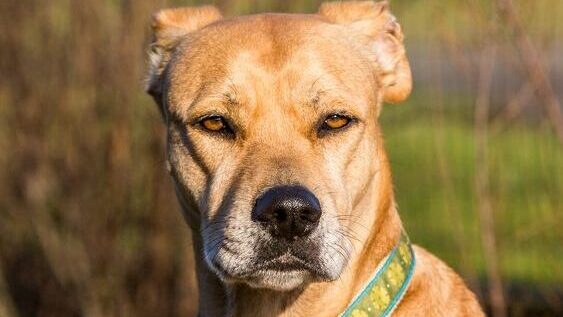
Labrabull Characteristics
Height & Weight
The Pitbull Lab mix is a medium to medium-large dog that weighs 30 to 80 pounds and stands at 15 to 30 inches in adulthood. Males tend to be larger than their female counterparts.
As always the size range stems from the range of sizes that occurs between and within breeds.
Physical Appearance
- Most Labrabulls possess strong, stocky, athletic, balanced, and smoothly muscled physiques. They should be without excess fat for long work hours in difficult terrain.
- Most skulls are broad with powerful jaws, wide noses, fleshy cheeks, and facial features borrowed from both parents. Their muzzles are well-sized neither short and stubby nor long and narrow with inviting almond-shaped eyes
- They have strong and compact feet with well-developed paw pads with skin connecting the toes (webbed feet). Their mouths are soft to pick and hold things gently
- Some may inherit the Lab’s lovely medium-length otter tail extending no longer than the hock. This tail is rounded and thick at the base with a gradual taper to the tip
These are general predictions as there is no way of knowing how a pup will turn out as an adult in about 12 months.
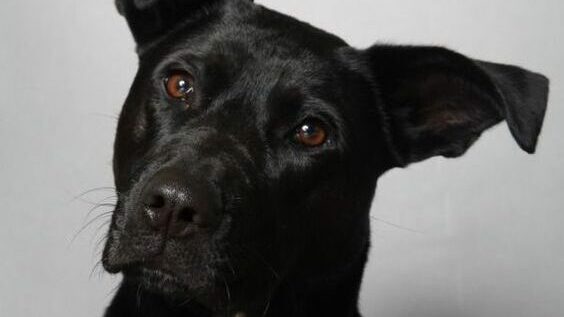
Coat Appearance
Most Lab Pit mixes are endowed with short, smooth, shiny, dense, water-resistant coats lying plush on the skin. These beautiful coats protect them from water and keep them warm in chilling weather and waters.
However, these dense coats tend to shed quite much with two heavy-shedding blowout seasons every year.
Colors:
Labrabulls come in a variety of coat colors and patterns (color combinations). They include;
- Black Lab Pitbull mix: The All black coat is caused by dominant black or recessive agouti genes. They have black skin, nose leather, eye rims, paw pads, and dark brown eyes. Some black Labrabulls have white markings on the chest and/or the face, underbelly, paws, or covering most of the coat. This coat color can be modified by other genes including the brown, blue, and white spotting genes.
- Brown or Chocolate Labrabull: Ranges from a rich dark brown (chocolate/liver) to medium brown. This coat color is caused by the modification of black color pigment (eumelanin) by a pair of the brown gene denoted as “b/b”. They may also have white markings on part or most of the coat.
- Blue Lab Pit mix: Ranges from steel blue to pale blue. Is caused by the dilution/lower concentrations of the black eumelanin pigment by a pair of dilution genes (d/d) causing it to appear bluish. They may have white markings on part or most of the coat.
- Brindle Lab Pitbull mix: Brindle is a pattern of alternating and irregular stripes of darker and lighter colors such as black and tan. This pattern is caused by the brindle gene denoted as Kbr.
- Fawn/Yellow Bullador: These dogs range from mahogany red to tan to golden to light cream in color. Fawn Pitbull Labs may have a black/brown/blue mask around their muzzle (melanistic mask).
- Sable Labrabull: Sable dogs have individual hairs of alternating dark and light pigments known as hair banding. The base of the hair tends to be of lighter color with dark tips.
- Tan Point Lab Pit mix: Tan point dogs are predominantly black, brown, blue, or isabella with red/tan/cream markings above the eyes, cheeks, muzzle, chin, chest, underbelly, legs, and under the tail.
- White/Piebald Pitbull Lab: This can range from a white patch on the chest that may extend to the face, on the feet/paws, underbelly, and tail tip. On some dogs white is the predominant color with a few black patches and possibly tiny black spots known as ticking.
Nose & Eye color:
The nose and skin color depend on eumelanin pigmentation. Eumelanin pigment, which is black by default, is one of two melanin pigments that determine all colors in mammals. Pheomelanin, red by default, is the other pigment.
When black eumelanin pigment is prevalent, the skin appears black, and the eyes are dark brown. Skin includes nose leather, eye rims, lips, and paw pads.
But the brown gene (mutant TYRP1 gene) causes the pigment-producing cells (melanosomes) to produce brown eumelanin pigment instead of black. These dogs have brown skin and hazel green/amber eyes.
The black eumelanin pigment can also be modified by the dilution gene which reduces the concentration of black eumelanin pigment causing any eumelanistic areas to appear bluish. These dogs have bluish skin and nose leather and hazel blue eyes.
When two pairs of both the brown and dilution genes are present, all eumelanistic areas appear pale brown also known as lilac or isabella. These dogs have pale brown skin and nose leather and sky blue/light blue eyes.
The piebald gene can also remove pigment from random sections of the eyes, skin, and nose leather. The skin on Piebald Labrabulls has random sections pink of pink skin that may also include the nose. Noses with pink spots are known as butterfly noses. Although rare, the piebald gene can remove pigment from one or both eyes, a section of an eye, a spot on one or both eyes or not affect any of the eyes. Any affected section will be blue.
Lab Pit mix Temperament & Personality
Although Pitbull Labs are great for a large group of individuals and families, not all of their traits may suit your lifestyle.
Owning any dog requires commitment and an understanding of the dog, its hardwired traits, how to shape them, care, training, and management among others. The environment, age, sex, personal experience, and lifestyle also have a huge impact on the dog’s behavioral traits.
That aside, most Lab Pits are sweet-tempered, high-energy, intelligent, devoted, cheerful, goofy, outgoing, clingy, loyal, loving, and sometimes serious and laid back. However, some can be quite shy, especially toward strangers, and can exhibit destructive behavior such as chewing, digging, scratching, frequent barking, etc when bored. An untrained Bullador can be unmanageable due to their enthusiasm and size.
These people-oriented dogs thrive on human love, warmth, and attention. They are obedient and are their owners’ couch potatoes whom they love to lick to death and connect with even during hard times. If you are a busy person with no one home to assist you, this may not be the dog for you.
With any crossbreed, you can never know what to expect, and predicting exact personality traits is not possible. Some pups may be more like one parent than the other and some may be a perfect blend of both parent breeds.
All in all, personality is unique to each animal and depends on a host of factors.
As a Companion & Family dog:
Most Pitbull Lab crosses are kind, protective, social, and well-tempered dogs that are great and fun to be around. This makes them bomb-proof family and companion dogs.
They are patient and gentle with children of all ages and are happy to enjoy the occasional game of fetch and zeal of life.
Though most don’t bite children unless provoked. However, they require appropriate training and supervision to tone down their exuberance and reduce constant knockdowns as they run, jump, and lumber around. Set their rules of play and engagement such as not allowing a baby or toddler child to interrupt the dog’s meals, and play rough among others. For older kids, let them understand how to deal with dogs.
This dog is ideal for a variety of situations given its needs are met including opportunities to play, exercise, and adventure to burn up pent-up energy. They thrive in an outdoor space where they can be free and curious goofballs.
Coexistence with other Animals:
Most Pitbull Retrievers are peaceful and playful with other animals, especially those they grow together with. But some may see the need to assert their dominance toward household pets and other dogs.
As mentioned earlier, some may show signs of dog aggression and this trait has been shown as heritable. It is possible the trait may be passed down to the Bullador from the Pitbull parent. Even then, levels of aggression vary between dogs.
Again, constant and proper social interactions from an early age are key for a happy and playful dog. Introduce them slowly to new dogs and build positive experiences to mitigate the trait to a great degree.
Labrabull Price
A Labrabull puppy costs between $400 and $1500 depending on the breeder, location, pedigree, and other price factors.
Selecting a Puppy
Decide whether your ideal puppy is a male or female, the color, temperament, and others. If possible, contact several breeders in the list of your local kennel clubs and ask to meet the available puppies.
Ask to see and meet both parents or the mother at least, where the pups are raised. They should have undergone the necessary health testing for evaluations such as hip and elbow dysplasia among others. Find out about their history, their stocks, obedient training, and field trials.
Both the parents and the pups should be healthy, sociable, friendly, and non-aggressive. Watch for good sanitation and hygiene
A reputable breeder is always looking for the best home possible for puppies. He/she should be willing to engage with you and ask questions about you and provide all necessary information including the diet, training, socialization progress, and so on.
Puppy-proofing
Puppy proofing prepares for the pup’s arrival by maximizing comfort and keeping him safe from choke elements, deadly plants, injury, mishandling, and unsafe interactions. It also removes valuable items such as jewelry, shoes, handbags, etc.
Some items that can cause possible harm include;
- Citronella candles
- Fishing hooks, baits, nails, drills, and other possible choke items he may chew on
- Some house and garden plants, compost piles, fertilizer, bioreactors, and so on
- Cleaning solutions and materials
Close off doors or block off some rooms if necessary and pick up after yourself to reduce any harm that might be caused by choke hazards. Keep harmful items out of the pup’s reach and provide him with chew toys instead.
Provide shelter and space with comfortable bedding to shield him from the elements, extreme heat, or cold. Also, limit the time you spend outdoors in cold or hot weather.
Have a high enough fence in the yard for him from escaping and protect him from outside threats. These dogs can be quite deft at digging under fences, scaling over low barriers, squeezing through spaces in the fence, etc. With some foresight, planning, and creative thinking, you can make the yard safer and prevent escape attempts.
Ensure the pup’s room is well-ventilated and has proper lighting when it gets dark even when you are away.

Pit Lab Routine Care
Build a routine care schedule for a healthy and happier pup. Care involves grooming, physical and mental stimulation, grooming, a high-quality diet, training and socialization, and vet visits among others.
Grooming
The Pit Lab mix is a short-coated dog that needs a brush down with a slicker brush at least twice a week to eliminate dead hair and keep them clean. Brushing the coat also distributes natural oils for a healthy and shiny coat. This is also a great opportunity to examine the coat for signs of health concerns and strengthen your bond.
You do not need to bathe this dog quite often. Washing the coat once a month or when necessary with warm water and pH-neutral doggie shampoo is enough to clean the dog and free of odor. Too much shampooing strips the coat of its natural oils causing the skin to dry. Between baths use a damp cloth or cotton wipes to wipe down the dog.
For dental hygiene brush the teeth at least once a week using a doggie toothbrush or finger brush and a vet-recommended doggie toothpaste. Chew toys and treats are also helpful for healthy teeth.
Clean the ears about once each fortnight with cotton buds and an ear-cleaning solution to remove any wax build-up.
Each time you hear the toenails clattering on the floor, it may be time to trim them using the right nail clippers and clipping techniques.
Start grooming as early as you get the Pitador used to touch in different body parts including the paws. Reward the dog for being calm as you build a positive grooming experience.
Pitador Diet & Nutrition
Choosing an appropriate, palatable, digestible, and balanced diet for your Labrabull to sustain energy and provide the right quality and proportions of nutrients. Appropriate means one matched for your dog’s age and activity level. Dog food can be dry (kibble), semi-moist, or wet (canned).
Commercial foods are the most common and are made of protein ingredients such as beef, lamb, chicken, and grains such as wheat, corn, rice, barley, or oat. Vitamins and minerals are added to balance the diet.
Most commercial foods are age-specific and are either formulated for a puppy, adult, senior, or all life stages. Some are vet-administered therapeutic diets for dogs deficient in one or more nutrients.
Homemade food formats are for those that prefer to prepare their pet’s food and tasty treats themselves. Consult a nutritionist for individualized recipes or for guidance as you prepare your recipe.
Avoid foods with bulking agents/fillers or chemical additives. The food should be free of excesses and toxins. Human foods and table scraps rarely meet the dog’s energy and nutritional needs without overfeeding or health impairments.
Energy Needs
An adequate calorie intake, expressed as kcal (kilocalories/calories), is required to sustain daily activities. Bodyweight, activity level, age, metabolic rate, body condition, environment, and other variables should be taken into account when estimating a dog’s energy requirements. Puppies, adolescents, adult dogs, seniors, lactating mothers, and overweight dogs have different energy needs. Adjust a pet’s requirements accordingly.
But as a general rule of thumb, adult dogs need about 30 calories for every pound they weigh. This is a ballpark figure that should be adjusted per individual circumstances as energy needs are not a one-size fits all endeavor. Even calorie calculators don’t take unique situations into account.
Offer the dog multiple well-spaced portions meals and stick to routine meal intervals using a feeding schedule.
| Guide | 1500 to 2000 calories |
| Cups of Kibble | 3 to 4 |
Nutritional needs
Dogs need adequate amounts of about 40 essential nutrients and macronutrients. Some of the nutrients can be synthesized by the dog’s body but others need to be taken in as food. The nutrients that should be provided in the diet are known as essential nutrients while macronutrients are required in small amounts.
- Proteins are made up of amino acids that provide the blocks to build and repair active compounds such as organs, and tissue. These proteins can be obtained from meat-based sources such as fish, eggs, and chicken and vegetables such as soy and cereal gluten. Different protein sources have different levels of digestible amino acids some of which are better for some dogs than others whether meat or vegetable based. How much protein the dog can break down after consumption is the most important consideration. Puppies and senior dogs require lower protein amounts and higher carbs while adolescent pups (6 to 24 months) need more protein to sustain their growth spurts. High-quality proteins have the right balance of essential amino acids. Each dog has circumstances unique to it. Consult a vet and/or nutritionist for recommendations on how to prepare the best diet for your Lab Pit.
- Dietary fats and oils are rich in energy, and essential fatty acids and enhance food taste and texture. Fatty acids such as omega-3 and omega-6 are required for healthy skin and coat, a strong immune system, mobility, reproduction, cell structure, and function. Some sources of fatty acids include salmon, flaxseeds, or other animal or plant-based fats.
- Carbs, starch, and fibers when provided in the diet are a valuable energy source and glucose. However, carbohydrates are not essential macronutrients as dogs can synthesize their own blood glucose from amino acids. Common sources of carbs include rice, barley, and potato.
- Vitamins although required in lower proportions are involved in a variety of essential metabolic functions. Deficiencies in some proteins can cause a variety of health complications but in excess, some vitamins can be toxic.
- Essential minerals and salts such as zinc, calcium, phosphorous, potassium, copper, and sodium are crucial for healthy body functioning
- A constant clean water supply is required for hydration
Nutrition is complex but the bottom line is that not all foods are created equal and not all high-protein diets are suitable for all dogs. A good balance of calories, proteins, vitamins, and minerals is crucial for a healthy Pit Lab mix puppy. But not all dogs have similar nutritional needs. You may be required to complement some nutrients in your Pitbull Labrador’s food for overall health.
Exercise requirements
This fun-loving ball of energy needs about 1 hour of physical and mental stimulation to burn up pent-up energy and maintain a healthy weight. Sufficient exercise and being outdoors have been shown to lower aggression and agitation, reduce incessant barking, ease boredom, lower excitability, and improve overall behavior and cognition.
If you are outdoorsy and love the occasional walk, running, cycling, hiking, games like fetch or tug, agility, swimming, and other treats this may be the dog for you. Swimming is great for this dog’s joints, so, if you are close to a dog-friendly beach, a lake, a pool, or access to a safe and clean swimming spot, revel in the joy of water with this dog as they take it in quite well. But the dog must first learn to wade in the water somewhere safe.
When outdoors, use a collar/harness and a loose leash to better control the dog as he sniffs around and explores.
Test your dog’s mental abilities with brain games such as puzzles, dog sports, agility competitions, scent work, freestyle, tracking, trick training, and so on
Lack of sufficient exercise or a job to do, turns these dogs obsessive and destructive, especially if they are in the hyper-adolescent stage. They may engage in chewing, higher barking tendencies, digging, scratching, and other destructive behavior to express their frustration and entertain themselves.
Nonetheless, avoid overexercising this pooch by watching out for signs of exhaustion such as slower movement, and excessive panting. As with most things in life, you should strike the proper exercise balance.
Also, do not feed it just after exercise as this can cause bloating and digestive problems.
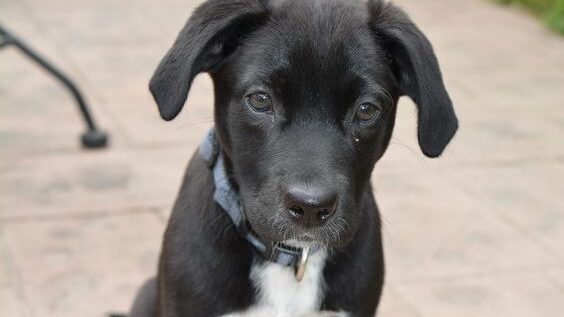
Pit Lab Mix Training & Socialization
Training is the process of educating and guiding your dog to a happy, confident, and healthy lifestyle, adjusting well to society, enhancing your friendship, and reinforcing good manners. The dog learns what to do and what not to do. Do not forget the fact that your Pitbull Lab is not human and has to learn the nuances of the human society
Labrabulls relish chances to learn and because they are quite intelligent are able to pick up commands with ease. Positive reinforcement, operant conditioning, and reward-based training have been shown to have high rates of success.
Focus on recall training, barking training, potty training, obedience training, loose leash walking, and tricks such as sit, heel, stay, wait, jump, paw, roll, and drop it. These are just examples as there is a lot you can teach this brilliant dog beyond the scope of this guide.
Proper socialization also plays a huge role in behavior shaping and makes him a better companion for you and your pets. Introduce and expose him to an array of different people, animals, cars, places, and experiences for improved social interactions.
An untrained and unsocialized dog is a constant source of embarrassment that scratches, chews on things, make holes in your yard, chase, pull on the leash, escape leash, get into dog fights, jump on people, hump and participate in other upsetting behaviors.
Make your dog feel wanted as they don’t respond well to physical and mental punishment. Do not yell at or beat the dog. The best way to correct this dog is to catch him in the act. Conversely, do not delay a positive reward after a desired behavior or action as dogs do not have recall on what they are corrected or rewarded for when done later. Make training fun and keep training sessions short.
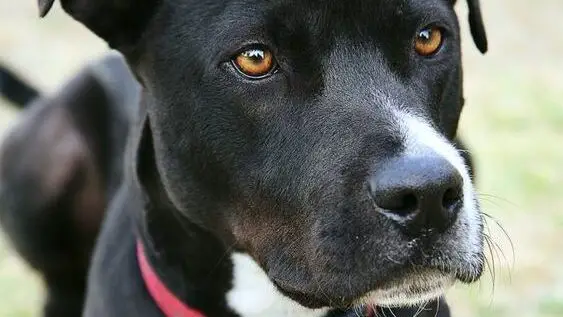
Pitador Health Concerns
Any mixed dog can be predisposed to some of the health conditions common to either parent. Some of the complications that can occur in a Pitbull Lab mix include;
- Bloat (Gastric Dilatation Volvulus)
- Hip and Elbow dysplasia
- Heart Disorders
- Progressive Retinal Atrophy ‘
- Eye issues
- Allergies
Signing for pet health insurance can help cover medical tests, emergency procedures, and other medical costs.
Is the Pit Lab mix a good dog?
To reap the benefits of owning any dog, training and how you raise them play a huge role in how good he is.
Providing an outlet for pent-up energy through physical and mental stimulation is also key for a well-rounded dog fit for a wide range of individuals and families.
It is also important to consider whether this dog is suitable for your lifestyle. It is important to have proper dog handling and training skills from a professional to guide you each step of the way. Like any other dog, they will push their boundaries as committing to raising a dog is an uphill battle.
There you go WOOF!!!
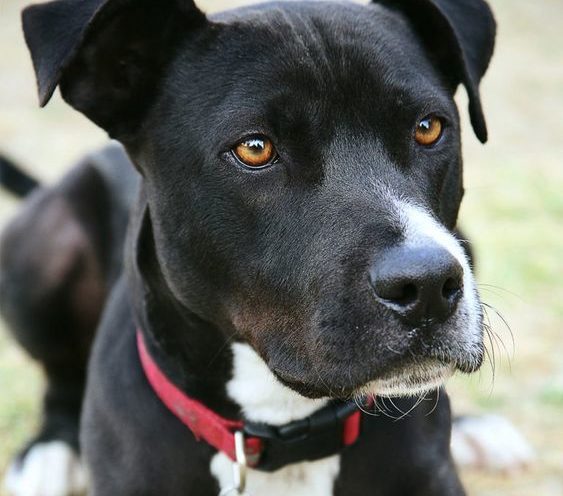
Dogs loyalty is imessurable